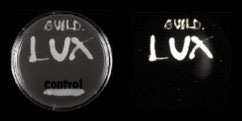Biological terror is a real threat that the Department of Homeland Security and the Department of Defense are grappling with. Accurate and quick detection of biological terror agents will be first and forefront for the detection and resulting cleanup of a terrorism event.
Guild BioSciences has pioneered biosensor research to improve the speed and accuracy of bacterial pathogen detection, culminating in the creation of the LumiPhage™ Bioluminescent Reporter Bacteriophage (phage). A reporter phage is a phage that is engineered to produce a signal upon infection of target bacteria. When a reporter phage infects the target bacteria, they commandeer the cells' machinery and produce a readily detectable signal, indicating that the target organisms are both present and viable. Guild BioSciences holds several patents and pending patent applications on reporter phage technologies in both the US and internationally.

Guild BioScienes has successfully demonstrated this technology on two bioterrorism agents, Bacillus anthracis (anthrax) and Yersinia pestis (plague). The technology affords fast and accurate detection, and is proven to operate in environmental samples, food samples, and clinical samples (human blood, tissue, or other sample).
LumiPhage offers the following advantages:
- Highly sensitive: Guild BioSciences scientists have achieved sensitivities as low as 101 CFU/mL.
- Highly specific: phage are naturally bacterial-specific. The Guild BioSciences team choose wisely when selecting a phage for reporter phage development, ensuring these phages have the appropriate specificity.
- Low cost: unlike molecular diagnostics, phage reagents are inexpensive.
- Rapid: Scientists at Guild BioSciences have been able to achieve impressive detection times that rival or surpass that of molecular-based approaches.
- Adaptable: the system can be adapted to fit high-throughput, high volume or single assay, low-volume scenarios.
- Simplicity: the procedure is simple and easy to perform, making it ideal for many different settings, such as clinical laboratories, point-of-care (POC), in-field, or food testing laboratories.

